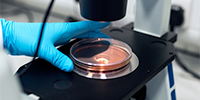Hyperspectral Endoscopic Microscopy for Optical Biopsies

Overview: We propose to develop a miniaturized hyperspectral microscope that can be placed at the tip of a pulmonary endoscope and create real-time hyper-spectral video imaging with close to diffraction-limited resolution.
Relation to One Utah Objective: (1) Our project addresses an important social and scientific/engineering problem of fast turn-around biopsies for early-stage cancer identification. This problem requires a highly inter-disciplinary collaboration between the 3 investigators. (2) The proposed research lies at the intersection of engineering, physics, medicine and mathematics. As a result, it is a difficult proposal to be judged effectively by traditional area-specialized panels at funding agencies. Secondly, the proposed research would be considered extremely risky without preliminary data from realistic samples. However, in order to obtain this preliminary data, one needs to develop all the foundational tools (which is the purpose of this project). (3) The funding will support a recent PhD graduate as post-doctoral researcher.
Methodologies: This highly inter-disciplinary research project involves (1) nanofabrication for the DFA, (2) optical system engineering for the microscopic endoscope, (3) algorithm development for solving the underlying inverse problems, (4) machine-learning algorithms for handling large data sets, (5) comprehensive experiments with representative samples and (6) data analysis to elucidate the efficacy of the approach.
Current Status
2021-09-15
Abstract:
Our objective is to develop a miniaturized hyperspectral microscope that can be placed at the tip of a pulmonary endoscope and create real-time hyper-spectral video imaging with close to diffraction-limited resolution.
The Menon and Guevara Vasquez labs have collaborated in the past to develop a computational hyper-spectral imaging technology for macroscopic imaging [1,2]. Our camera is based on simply introducing a transparent diffractive-filter array (DFA) onto a conventional image sensor, and by applying novel algorithms we can reconstruct the hyper-spectral image. This technology allows for: (1) very compact (miniaturized) hyper-spectral cameras, (2) flexibility in choice of spectral bands and resolution via software, and (3) high sensitivity since there is minimal photon loss (via absorption, for example). In this project, we propose to exploit these intrinsic advantages and extend this technology (augmented with machine learning) into a miniaturized form factor that can be embedded at the end of an endoscope with a particular emphasis on using it for pulmonary and Gastroenterology-oncology applications (which are led by Prof. Reddy).
Collaborators
Rajesh Menon
College of Engineering
Elect & Computer Engineering
Project Owner
Fernando Guevara Vasquez
College of Science
Mathematics
Chakravarthy Reddy
School of Medicine
Internal Medicine
Project Info
Funded Project Amount$30K
Keywords
Hyperspectral, endoscopy, microscopy, Biopsy
Project Status
Funded 2020
Poster
View poster (pdf)
